人教版2019年高中必修二 Unit 1 Cultural Heritage 单元知识总结清单(含练习题 写作句型范文)
文档属性
| 名称 | 人教版2019年高中必修二 Unit 1 Cultural Heritage 单元知识总结清单(含练习题 写作句型范文) | 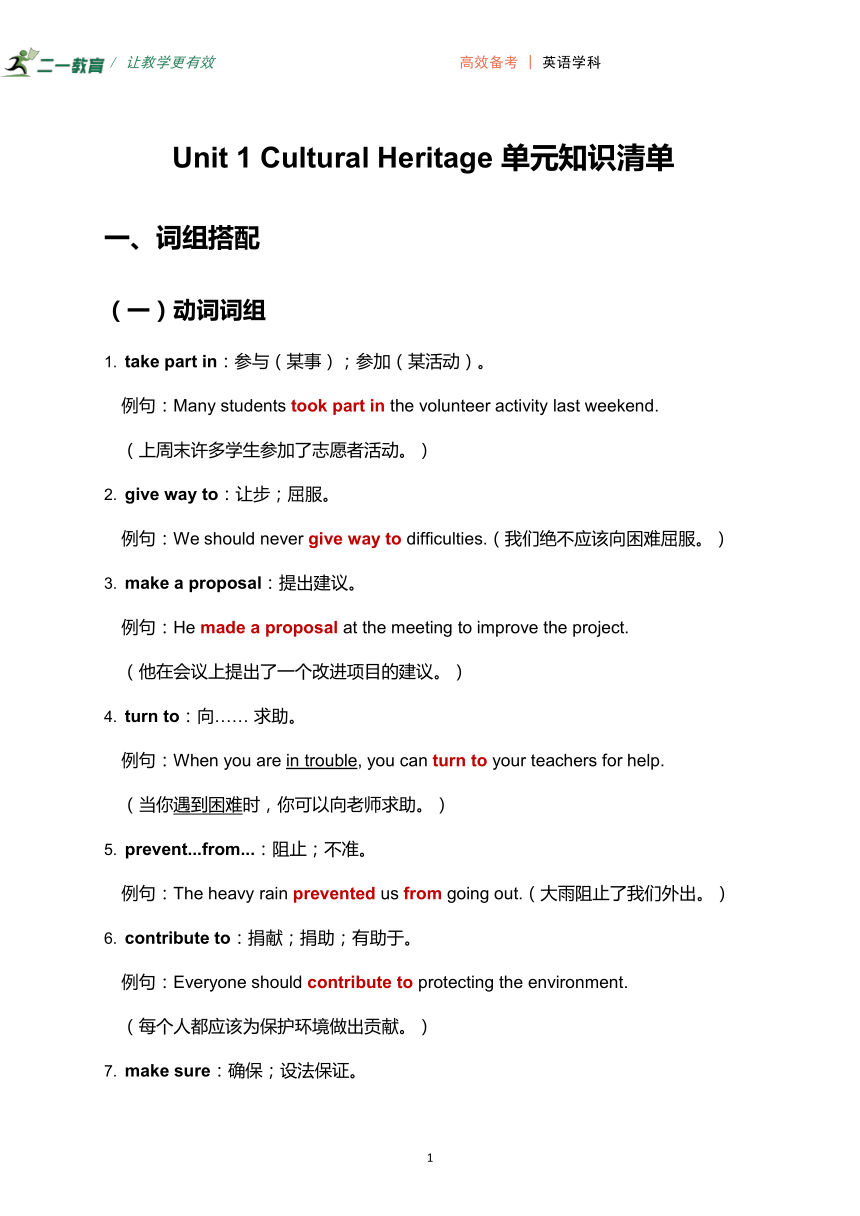 | |
| 格式 | docx | ||
| 文件大小 | 45.7KB | ||
| 资源类型 | 试卷 | ||
| 版本资源 | 人教版(2019) | ||
| 科目 | 英语 | ||
| 更新时间 | 2025-07-13 11:02:35 | ||
图片预览

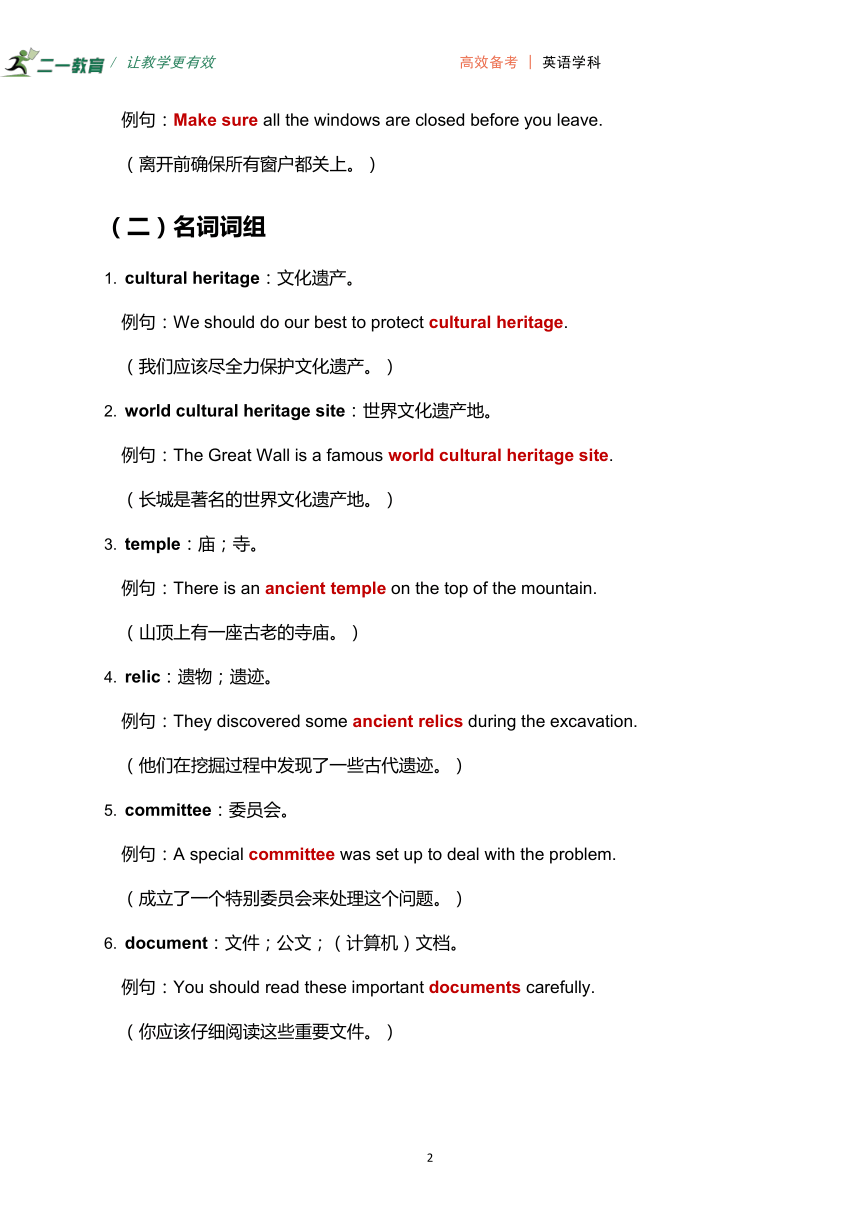
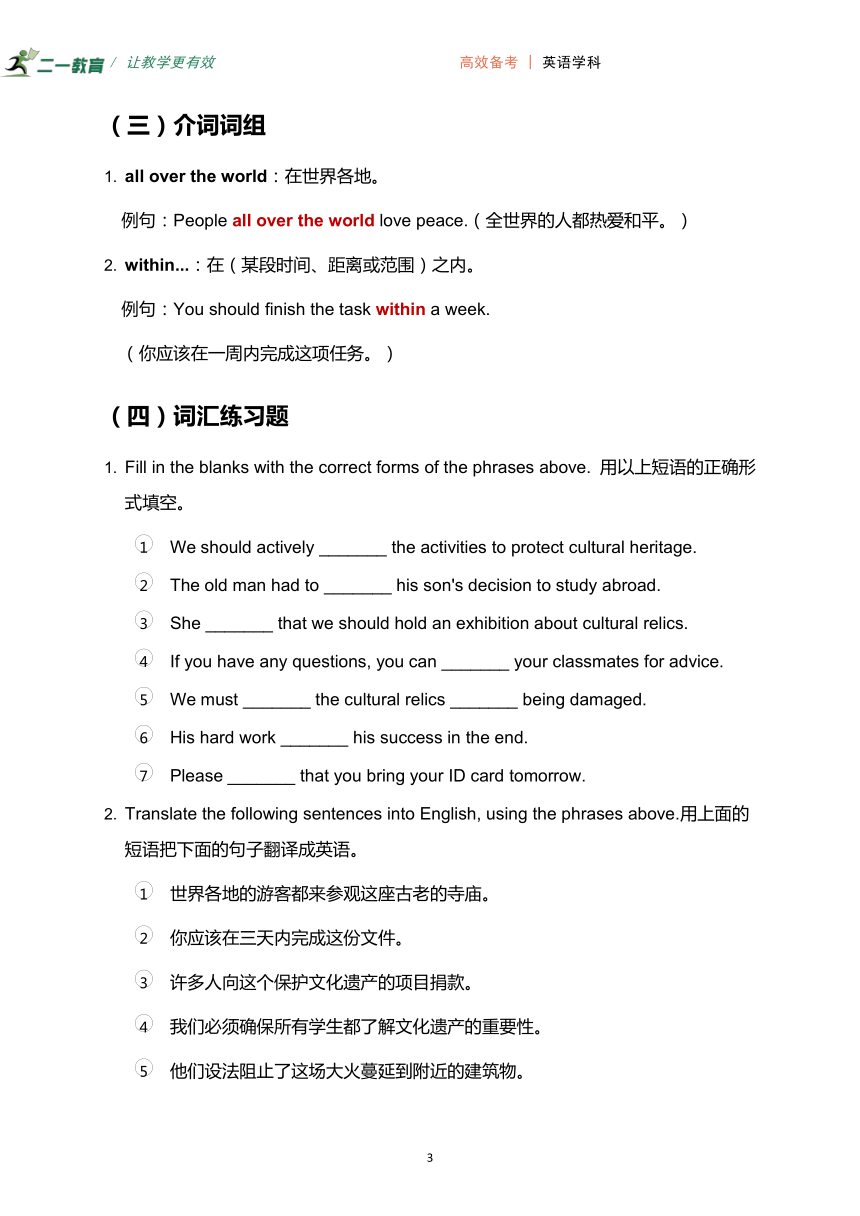
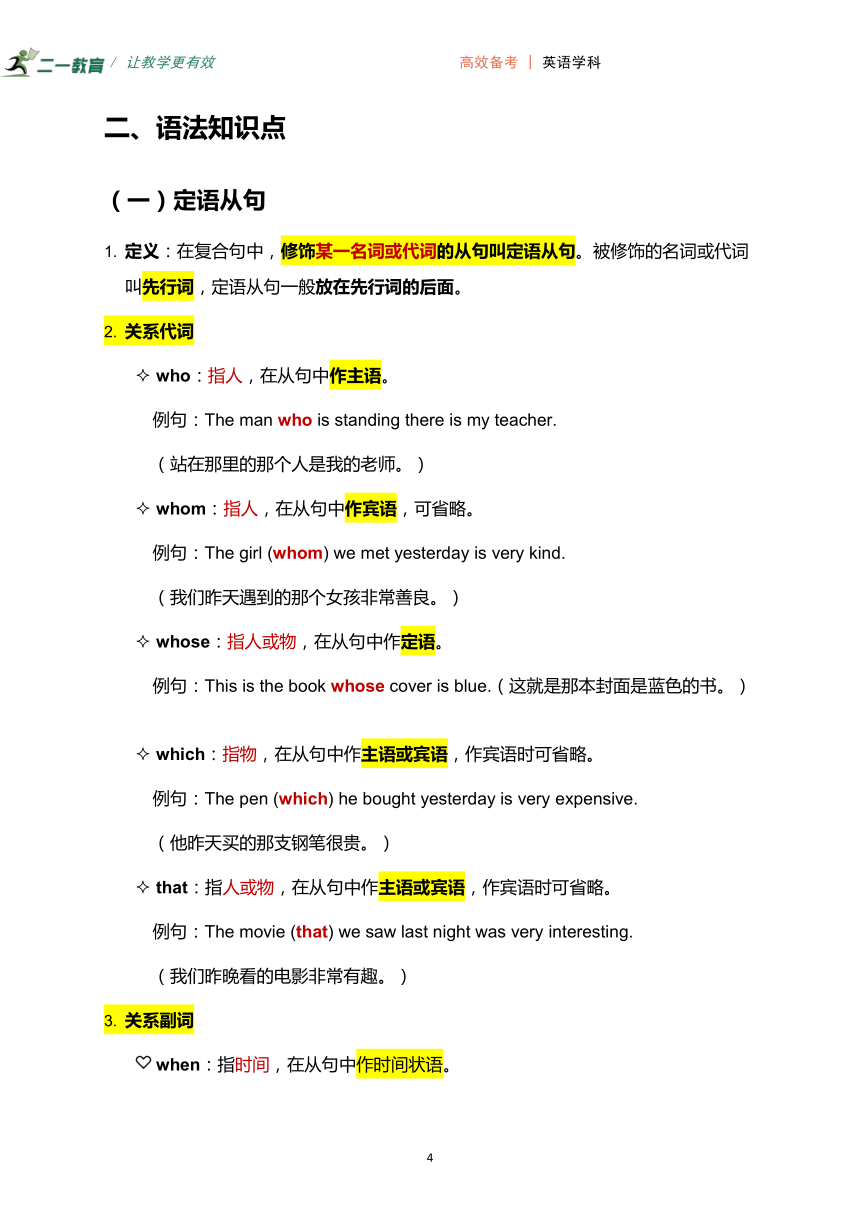
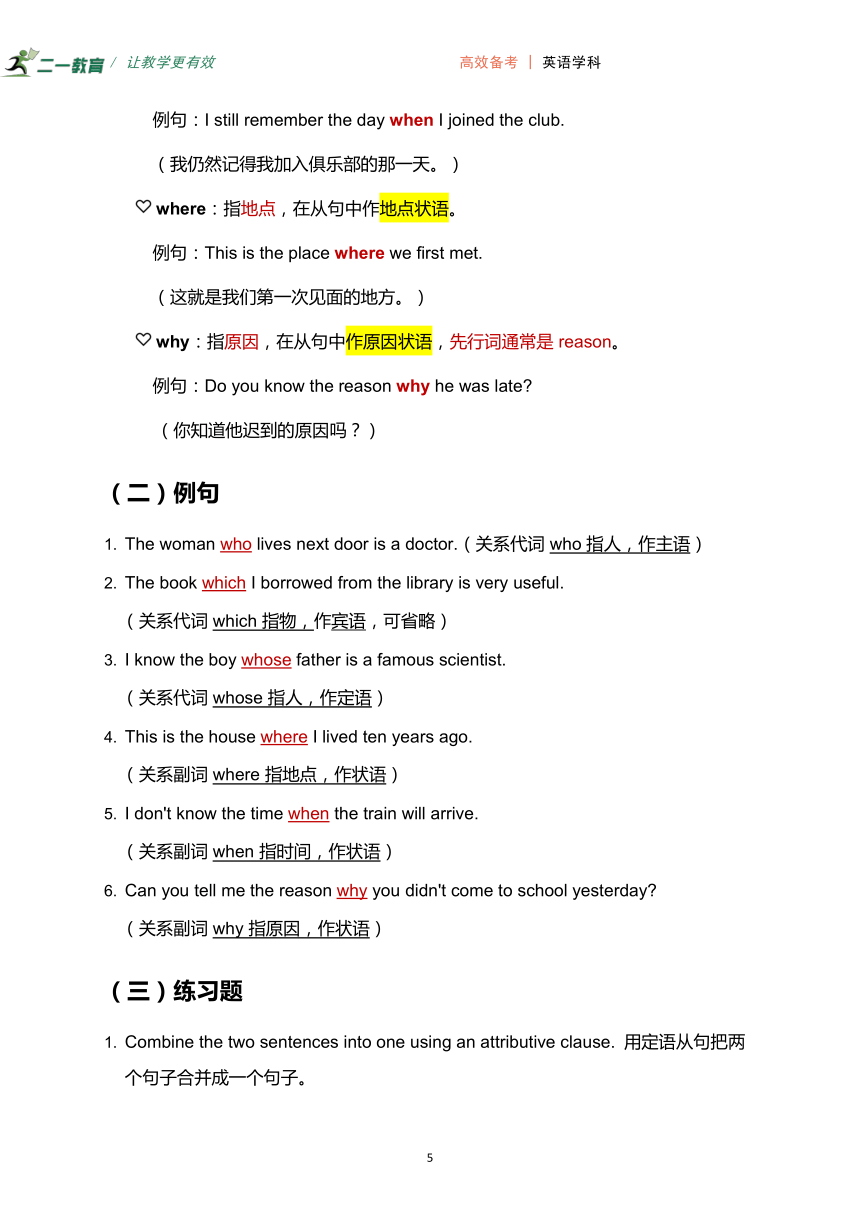
文档简介
/ 让教学更有效 高效备考 | 英语学科
Unit 1 Cultural Heritage 单元知识清单
一、词组搭配
(一)动词词组
take part in:参与(某事);参加(某活动)。
例句:Many students took part in the volunteer activity last weekend.
(上周末许多学生参加了志愿者活动。)
give way to:让步;屈服。
例句:We should never give way to difficulties.(我们绝不应该向困难屈服。)
make a proposal:提出建议。
例句:He made a proposal at the meeting to improve the project.
(他在会议上提出了一个改进项目的建议。)
turn to:向…… 求助。
例句:When you are in trouble, you can turn to your teachers for help.
(当你遇到困难时,你可以向老师求助。)
prevent...from...:阻止;不准。
例句:The heavy rain prevented us from going out.(大雨阻止了我们外出。)
contribute to:捐献;捐助;有助于。
例句:Everyone should contribute to protecting the environment.
(每个人都应该为保护环境做出贡献。)
make sure:确保;设法保证。
例句:Make sure all the windows are closed before you leave.
(离开前确保所有窗户都关上。)
(二)名词词组
cultural heritage:文化遗产。
例句:We should do our best to protect cultural heritage.
(我们应该尽全力保护文化遗产。)
world cultural heritage site:世界文化遗产地。
例句:The Great Wall is a famous world cultural heritage site.
(长城是著名的世界文化遗产地。)
temple:庙;寺。
例句:There is an ancient temple on the top of the mountain.
(山顶上有一座古老的寺庙。)
relic:遗物;遗迹。
例句:They discovered some ancient relics during the excavation.
(他们在挖掘过程中发现了一些古代遗迹。)
committee:委员会。
例句:A special committee was set up to deal with the problem.
(成立了一个特别委员会来处理这个问题。)
document:文件;公文;(计算机)文档。
例句:You should read these important documents carefully.
(你应该仔细阅读这些重要文件。)
(三)介词词组
all over the world:在世界各地。
例句:People all over the world love peace.(全世界的人都热爱和平。)
within...:在(某段时间、距离或范围)之内。
例句:You should finish the task within a week.
(你应该在一周内完成这项任务。)
(四)词汇练习题
Fill in the blanks with the correct forms of the phrases above.
用以上短语的正确形式填空。
We should actively _______ the activities to protect cultural heritage.
The old man had to _______ his son's decision to study abroad.
She _______ that we should hold an exhibition about cultural relics.
If you have any questions, you can _______ your classmates for advice.
We must _______ the cultural relics _______ being damaged.
His hard work _______ his success in the end.
Please _______ that you bring your ID card tomorrow.
Translate the following sentences into English, using the phrases above.用上面的短语把下面的句子翻译成英语。
世界各地的游客都来参观这座古老的寺庙。
你应该在三天内完成这份文件。
许多人向这个保护文化遗产的项目捐款。
我们必须确保所有学生都了解文化遗产的重要性。
他们设法阻止了这场大火蔓延到附近的建筑物。
二、语法知识点
(一)定语从句
定义:在复合句中,修饰某一名词或代词的从句叫定语从句。被修饰的名词或代词叫先行词,定语从句一般放在先行词的后面。
关系代词
who:指人,在从句中作主语。
例句:The man who is standing there is my teacher.
(站在那里的那个人是我的老师。)
whom:指人,在从句中作宾语,可省略。
例句:The girl (whom) we met yesterday is very kind.
(我们昨天遇到的那个女孩非常善良。)
whose:指人或物,在从句中作定语。
例句:This is the book whose cover is blue.(这就是那本封面是蓝色的书。)
which:指物,在从句中作主语或宾语,作宾语时可省略。
例句:The pen (which) he bought yesterday is very expensive.
(他昨天买的那支钢笔很贵。)
that:指人或物,在从句中作主语或宾语,作宾语时可省略。
例句:The movie (that) we saw last night was very interesting.
(我们昨晚看的电影非常有趣。)
关系副词
when:指时间,在从句中作时间状语。
例句:I still remember the day when I joined the club.
(我仍然记得我加入俱乐部的那一天。)
where:指地点,在从句中作地点状语。
例句:This is the place where we first met.
(这就是我们第一次见面的地方。)
why:指原因,在从句中作原因状语,先行词通常是 reason。
例句:Do you know the reason why he was late
(你知道他迟到的原因吗?)
(二)例句
The woman who lives next door is a doctor.(关系代词 who 指人,作主语)
The book which I borrowed from the library is very useful.
(关系代词 which 指物,作宾语,可省略)
I know the boy whose father is a famous scientist.
(关系代词 whose 指人,作定语)
This is the house where I lived ten years ago.
(关系副词 where 指地点,作状语)
I don't know the time when the train will arrive.
(关系副词 when 指时间,作状语)
Can you tell me the reason why you didn't come to school yesterday
(关系副词 why 指原因,作状语)
(三)练习题
Combine the two sentences into one using an attributive clause.
用定语从句把两个句子合并成一个句子。
The girl is my sister. She is wearing a red dress.
I have read the book. You lent me the book last week.
The man is a famous writer. He visited our school yesterday.
This is the factory. My father works in the factory.
I still remember the day. I met him on that day.
Translate the following sentences into English, using attributive clauses.
用定语从句把下列句子翻译成英语。
正在唱歌的那个女孩是我的表妹。
我喜欢可以跟着跳舞的音乐。
你认识住在隔壁的那个男孩吗?
这就是我丢钱包的地方。
你知道他缺席会议的原因吗?
三、重要句式句型分析
(一)There comes a time when...
结构:这是一个倒装句,正常语序为 “A time when...comes”,“when” 引导定语从句修饰 “time”。
功能:表示 “有时候会……;有这么一个时候……”。
例句:There comes a time when you have to make a decision by yourself.
(有时候你必须自己做决定。)
(二)Not only...but also...
结构:连接两个并列的成分,可以连接主语、谓语、宾语、表语等。当连接两个句子且 “Not only” 位于句首时,“Not only” 后的句子要部分倒装。
功能:表示 “不但…… 而且……”。
例句:Not only does he like reading books, but also he likes playing basketball.(他不但喜欢读书,而且喜欢打篮球。)
(三)翻译练习题
有时候我们必须学会向他人求助。
她不但会说英语,而且还精通法语。
不但学生们对这个话题感兴趣,老师也感兴趣。
有这么一个时候,我们需要勇敢地面对挑战。
四、单元书面表达写作指导
(一)重要词汇词组搭配积累
文化遗产相关词汇:cultural heritage, world cultural heritage site, relic, temple, historic, traditional
保护与行动相关词汇:protect, preserve, promote, rescue, contribute, establish, prevent
描述与评价相关词汇:valuable, important, unique, amazing, meaningful
词组搭配:take part in, give way to, make a proposal, turn to, prevent...from..., contribute to, all over the world
(二)高分句式积累
It is + adj. + for sb. to do sth.
例句:It is necessary for us to protect cultural heritage.
(对我们来说,保护文化遗产是必要的。)
As far as I'm concerned,...
例句:As far as I'm concerned, cultural heritage is the treasure of mankind.
(在我看来,文化遗产是人类的瑰宝。)
There is no doubt that...
例句:There is no doubt that cultural heritage protection is of great significance.(毫无疑问,文化遗产保护意义重大。)
In order to..., we should...
例句:In order to protect cultural heritage, we should raise public awareness.
(为了保护文化遗产,我们应该提高公众意识。)
(三)参考范文
Protecting Cultural Heritage
Cultural heritage is our precious legacy from the past, which not only represents the history and traditions of a country or society but also enriches our spiritual world. However, with the development of society, many cultural heritage sites are facing various threats, so it is crucial to take measures to protect them.
Firstly, we should raise public awareness of cultural heritage protection. Through education and publicity, people can understand the importance of cultural heritage and actively participate in its protection. For example, schools can organize students to visit cultural heritage sites and hold relevant lectures to let students know more about cultural heritage.
Secondly, the government should play a leading role. It can establish laws and regulations to ensure the protection of cultural heritage. Also, the government can allocate funds to support the maintenance and restoration of cultural heritage sites. In addition, international cooperation is also necessary. Many countries can work together to share experience and technology in cultural heritage protection, just like the Aswan Dam project, which successfully protected the cultural heritage with the help of the global community.
In conclusion, protecting cultural heritage is a long - term and arduous task that requires the joint efforts of everyone. Only by doing so can we pass on these precious heritages to future generations and let them continue to shine with glory.
练习题答案及解析
一、词组搭配练习题
(一)Fill in the blanks with the correct forms of the phrases above
答案:take part in
解析:“the activities to protect cultural heritage”(保护文化遗产的活动),“take part in” 表示 “参与(某事);参加(某活动)”,句子表达我们应积极参与这类活动,符合语境 。
答案:give way to
解析:“the old man”(老人)和 “his son's decision to study abroad”(他儿子出国留学的决定),“give way to” 有 “让步;屈服” 之意,这里指老人不得不对儿子的决定让步,语义通顺 。
答案:made a proposal
解析:“that we should hold an exhibition about cultural relics”(我们应该举办一个关于文物的展览),“make a proposal” 表示 “提出建议”,句子时态为一般过去时,所以用 “made a proposal” ,说明她提出了这样一个建议 。
答案:turn to
解析:“If you have any questions”(如果你有任何问题)和 “your classmates for advice”(向你的同学寻求建议),“turn to” 意为 “向…… 求助”,符合在有问题时向同学求助的逻辑 。
答案:prevent; from
解析:“the cultural relics”(文物)和 “being damaged”(被损坏),“prevent...from...” 表示 “阻止;不准”,即我们必须阻止文物被损坏,“from” 后接动名词形式 。
答案:contributed to
解析:“His hard work”(他的努力工作)和 “his success”(他的成功),“contribute to” 有 “有助于” 的意思,句子描述过去发生的事情,用一般过去时 “contributed to”,表示他的努力最终促成了成功 。
答案:make sure
解析:“that you bring your ID card tomorrow”(你明天带上身份证),“make sure” 表示 “确保;设法保证”,此句是祈使句,用动词原形,意思是确保明天带上身份证 。
(二)Translate the following sentences into English, using the phrases above
答案:Tourists all over the world come to visit this ancient temple.
解析:“世界各地的” 用 “all over the world”,修饰 “tourists”(游客);“来参观” 用 “come to visit”;“这座古老的寺庙” 翻译为 “this ancient temple”,按照英语语序组合成句 。
答案:You should finish this document within three days.
解析:“应该” 用 “should”,“完成这份文件” 是 “finish this document”;“在三天内” 使用 “within three days”,“within” 表示 “在(某段时间)之内” 。
答案:Many people contributed to the project of protecting cultural heritage.
解析:“许多人” 是 “Many people”;“向…… 捐款” 用 “contribute to”;“保护文化遗产的项目” 翻译为 “the project of protecting cultural heritage”,“of” 表示所属关系 。
答案:We must make sure all students understand the importance of cultural heritage.
解析:“必须” 用 “must”,“确保” 用 “make sure”,其后接宾语从句;“所有学生都了解文化遗产的重要性” 翻译为 “all students understand the importance of cultural heritage”,从句用陈述语序 。
答案:They managed to prevent the fire from spreading to nearby buildings.
解析:“设法做某事” 用 “manage to do sth.”,句子时态用一般过去时,“manage” 的过去式是 “managed”;“阻止…… 蔓延” 用 “prevent...from...”,“from” 后接动名词 “spreading”;“附近的建筑物” 翻译为 “nearby buildings” 。
二、语法知识点练习题答案
(一)Combine the two sentences into one using an attributive clause
答案:The girl who/that is wearing a red dress is my sister.
解析:先行词是 “the girl”(指人),在从句中作主语,所以可以用关系代词 “who” 或 “that” 引导定语从句,将两个句子合并为 “穿红裙子的女孩是我的妹妹” 。
答案:I have read the book (which/that) you lent me last week.
解析:先行词是 “the book”(指物),在从句中作宾语,关系代词可以用 “which” 或 “that”,也可以省略,合并后句子为 “我已经读了你上周借给我的那本书” 。
答案:The man who/that visited our school yesterday is a famous writer.
解析:先行词是 “the man”(指人),在从句中作主语,可用 “who” 或 “that” 引导定语从句,合并后表示 “昨天参观我们学校的那个人是一位著名作家” 。
答案:This is the factory where my father works.
解析:先行词是 “the factory”(指地点),在从句中作地点状语,所以用关系副词 “where” 引导定语从句,句子意思是 “这就是我父亲工作的工厂” 。
答案:I still remember the day when I met him.
解析:先行词是 “the day”(指时间),在从句中作时间状语,用关系副词 “when” 引导定语从句,即 “我仍然记得我遇见他的那一天” 。
(二)Translate the following sentences into English, using attributive clauses
答案:The girl who/that is singing is my cousin.
解析:“正在唱歌的” 修饰 “女孩”,先行词 “the girl”(指人)在从句中作主语,用关系代词 “who” 或 “that” 引导定语从句,“is singing” 是现在进行时表示正在进行的动作 。
答案:I like the music (which/that) I can dance to.
解析:先行词是 “the music”(指物),在从句中作 “dance to” 的宾语,关系代词可用 “which” 或 “that”,也可省略,“I can dance to” 是定语从句,修饰 “the music” 。
答案:Do you know the boy who/that lives next door
解析:先行词是 “the boy”(指人),在从句中作主语,用 “who” 或 “that” 引导定语从句,“lives next door” 表示住在隔壁,句子是一般疑问句 。
答案:This is the place where I lost my wallet.
解析:先行词是 “the place”(指地点),在从句中作地点状语,用关系副词 “where” 引导定语从句,“I lost my wallet” 说明在这个地方发生的事情 。
答案:Do you know the reason why he was absent from the meeting
解析:先行词是 “the reason”(指原因),在从句中作原因状语,用关系副词 “why” 引导定语从句,“be absent from” 表示缺席,句子为一般疑问句 。
三、重要句式句型分析翻译练习题答案
答案:There comes a time when we must learn to turn to others for help.
解析:使用 “There comes a time when...” 结构,“when” 引导定语从句修饰 “time”;“学会向他人求助” 翻译为 “learn to turn to others for help”,“turn to...for help” 是固定搭配 。
答案:Not only can she speak English, but also she is proficient in French.
解析:“Not only...but also...” 连接两个句子,“Not only” 位于句首,其后的句子 “she can speak English” 要部分倒装,将情态动词 “can” 提到主语 “she” 前面;“精通” 用 “be proficient in”,“but also” 后的句子语序不变 。
答案:Not only are the students interested in this topic, but also the teachers are.
解析:“Not only...but also...” 连接两个句子且 “Not only” 位于句首,“the students are interested in this topic” 部分倒装,将系动词 “are” 提到主语 “the students” 前面;“but also” 后的句子保留正常语序,为避免重复,用 “the teachers are” 。
答案:There comes a time when we need to face challenges bravely.
解析:运用 “There comes a time when...” 结构,“when” 引导定语从句;“需要勇敢地面对挑战” 翻译为 “need to face challenges bravely”,“face challenges” 表示面对挑战,“bravely” 作状语修饰 “face” 。
Unit 1 Cultural Heritage 单元知识清单
一、词组搭配
(一)动词词组
take part in:参与(某事);参加(某活动)。
例句:Many students took part in the volunteer activity last weekend.
(上周末许多学生参加了志愿者活动。)
give way to:让步;屈服。
例句:We should never give way to difficulties.(我们绝不应该向困难屈服。)
make a proposal:提出建议。
例句:He made a proposal at the meeting to improve the project.
(他在会议上提出了一个改进项目的建议。)
turn to:向…… 求助。
例句:When you are in trouble, you can turn to your teachers for help.
(当你遇到困难时,你可以向老师求助。)
prevent...from...:阻止;不准。
例句:The heavy rain prevented us from going out.(大雨阻止了我们外出。)
contribute to:捐献;捐助;有助于。
例句:Everyone should contribute to protecting the environment.
(每个人都应该为保护环境做出贡献。)
make sure:确保;设法保证。
例句:Make sure all the windows are closed before you leave.
(离开前确保所有窗户都关上。)
(二)名词词组
cultural heritage:文化遗产。
例句:We should do our best to protect cultural heritage.
(我们应该尽全力保护文化遗产。)
world cultural heritage site:世界文化遗产地。
例句:The Great Wall is a famous world cultural heritage site.
(长城是著名的世界文化遗产地。)
temple:庙;寺。
例句:There is an ancient temple on the top of the mountain.
(山顶上有一座古老的寺庙。)
relic:遗物;遗迹。
例句:They discovered some ancient relics during the excavation.
(他们在挖掘过程中发现了一些古代遗迹。)
committee:委员会。
例句:A special committee was set up to deal with the problem.
(成立了一个特别委员会来处理这个问题。)
document:文件;公文;(计算机)文档。
例句:You should read these important documents carefully.
(你应该仔细阅读这些重要文件。)
(三)介词词组
all over the world:在世界各地。
例句:People all over the world love peace.(全世界的人都热爱和平。)
within...:在(某段时间、距离或范围)之内。
例句:You should finish the task within a week.
(你应该在一周内完成这项任务。)
(四)词汇练习题
Fill in the blanks with the correct forms of the phrases above.
用以上短语的正确形式填空。
We should actively _______ the activities to protect cultural heritage.
The old man had to _______ his son's decision to study abroad.
She _______ that we should hold an exhibition about cultural relics.
If you have any questions, you can _______ your classmates for advice.
We must _______ the cultural relics _______ being damaged.
His hard work _______ his success in the end.
Please _______ that you bring your ID card tomorrow.
Translate the following sentences into English, using the phrases above.用上面的短语把下面的句子翻译成英语。
世界各地的游客都来参观这座古老的寺庙。
你应该在三天内完成这份文件。
许多人向这个保护文化遗产的项目捐款。
我们必须确保所有学生都了解文化遗产的重要性。
他们设法阻止了这场大火蔓延到附近的建筑物。
二、语法知识点
(一)定语从句
定义:在复合句中,修饰某一名词或代词的从句叫定语从句。被修饰的名词或代词叫先行词,定语从句一般放在先行词的后面。
关系代词
who:指人,在从句中作主语。
例句:The man who is standing there is my teacher.
(站在那里的那个人是我的老师。)
whom:指人,在从句中作宾语,可省略。
例句:The girl (whom) we met yesterday is very kind.
(我们昨天遇到的那个女孩非常善良。)
whose:指人或物,在从句中作定语。
例句:This is the book whose cover is blue.(这就是那本封面是蓝色的书。)
which:指物,在从句中作主语或宾语,作宾语时可省略。
例句:The pen (which) he bought yesterday is very expensive.
(他昨天买的那支钢笔很贵。)
that:指人或物,在从句中作主语或宾语,作宾语时可省略。
例句:The movie (that) we saw last night was very interesting.
(我们昨晚看的电影非常有趣。)
关系副词
when:指时间,在从句中作时间状语。
例句:I still remember the day when I joined the club.
(我仍然记得我加入俱乐部的那一天。)
where:指地点,在从句中作地点状语。
例句:This is the place where we first met.
(这就是我们第一次见面的地方。)
why:指原因,在从句中作原因状语,先行词通常是 reason。
例句:Do you know the reason why he was late
(你知道他迟到的原因吗?)
(二)例句
The woman who lives next door is a doctor.(关系代词 who 指人,作主语)
The book which I borrowed from the library is very useful.
(关系代词 which 指物,作宾语,可省略)
I know the boy whose father is a famous scientist.
(关系代词 whose 指人,作定语)
This is the house where I lived ten years ago.
(关系副词 where 指地点,作状语)
I don't know the time when the train will arrive.
(关系副词 when 指时间,作状语)
Can you tell me the reason why you didn't come to school yesterday
(关系副词 why 指原因,作状语)
(三)练习题
Combine the two sentences into one using an attributive clause.
用定语从句把两个句子合并成一个句子。
The girl is my sister. She is wearing a red dress.
I have read the book. You lent me the book last week.
The man is a famous writer. He visited our school yesterday.
This is the factory. My father works in the factory.
I still remember the day. I met him on that day.
Translate the following sentences into English, using attributive clauses.
用定语从句把下列句子翻译成英语。
正在唱歌的那个女孩是我的表妹。
我喜欢可以跟着跳舞的音乐。
你认识住在隔壁的那个男孩吗?
这就是我丢钱包的地方。
你知道他缺席会议的原因吗?
三、重要句式句型分析
(一)There comes a time when...
结构:这是一个倒装句,正常语序为 “A time when...comes”,“when” 引导定语从句修饰 “time”。
功能:表示 “有时候会……;有这么一个时候……”。
例句:There comes a time when you have to make a decision by yourself.
(有时候你必须自己做决定。)
(二)Not only...but also...
结构:连接两个并列的成分,可以连接主语、谓语、宾语、表语等。当连接两个句子且 “Not only” 位于句首时,“Not only” 后的句子要部分倒装。
功能:表示 “不但…… 而且……”。
例句:Not only does he like reading books, but also he likes playing basketball.(他不但喜欢读书,而且喜欢打篮球。)
(三)翻译练习题
有时候我们必须学会向他人求助。
她不但会说英语,而且还精通法语。
不但学生们对这个话题感兴趣,老师也感兴趣。
有这么一个时候,我们需要勇敢地面对挑战。
四、单元书面表达写作指导
(一)重要词汇词组搭配积累
文化遗产相关词汇:cultural heritage, world cultural heritage site, relic, temple, historic, traditional
保护与行动相关词汇:protect, preserve, promote, rescue, contribute, establish, prevent
描述与评价相关词汇:valuable, important, unique, amazing, meaningful
词组搭配:take part in, give way to, make a proposal, turn to, prevent...from..., contribute to, all over the world
(二)高分句式积累
It is + adj. + for sb. to do sth.
例句:It is necessary for us to protect cultural heritage.
(对我们来说,保护文化遗产是必要的。)
As far as I'm concerned,...
例句:As far as I'm concerned, cultural heritage is the treasure of mankind.
(在我看来,文化遗产是人类的瑰宝。)
There is no doubt that...
例句:There is no doubt that cultural heritage protection is of great significance.(毫无疑问,文化遗产保护意义重大。)
In order to..., we should...
例句:In order to protect cultural heritage, we should raise public awareness.
(为了保护文化遗产,我们应该提高公众意识。)
(三)参考范文
Protecting Cultural Heritage
Cultural heritage is our precious legacy from the past, which not only represents the history and traditions of a country or society but also enriches our spiritual world. However, with the development of society, many cultural heritage sites are facing various threats, so it is crucial to take measures to protect them.
Firstly, we should raise public awareness of cultural heritage protection. Through education and publicity, people can understand the importance of cultural heritage and actively participate in its protection. For example, schools can organize students to visit cultural heritage sites and hold relevant lectures to let students know more about cultural heritage.
Secondly, the government should play a leading role. It can establish laws and regulations to ensure the protection of cultural heritage. Also, the government can allocate funds to support the maintenance and restoration of cultural heritage sites. In addition, international cooperation is also necessary. Many countries can work together to share experience and technology in cultural heritage protection, just like the Aswan Dam project, which successfully protected the cultural heritage with the help of the global community.
In conclusion, protecting cultural heritage is a long - term and arduous task that requires the joint efforts of everyone. Only by doing so can we pass on these precious heritages to future generations and let them continue to shine with glory.
练习题答案及解析
一、词组搭配练习题
(一)Fill in the blanks with the correct forms of the phrases above
答案:take part in
解析:“the activities to protect cultural heritage”(保护文化遗产的活动),“take part in” 表示 “参与(某事);参加(某活动)”,句子表达我们应积极参与这类活动,符合语境 。
答案:give way to
解析:“the old man”(老人)和 “his son's decision to study abroad”(他儿子出国留学的决定),“give way to” 有 “让步;屈服” 之意,这里指老人不得不对儿子的决定让步,语义通顺 。
答案:made a proposal
解析:“that we should hold an exhibition about cultural relics”(我们应该举办一个关于文物的展览),“make a proposal” 表示 “提出建议”,句子时态为一般过去时,所以用 “made a proposal” ,说明她提出了这样一个建议 。
答案:turn to
解析:“If you have any questions”(如果你有任何问题)和 “your classmates for advice”(向你的同学寻求建议),“turn to” 意为 “向…… 求助”,符合在有问题时向同学求助的逻辑 。
答案:prevent; from
解析:“the cultural relics”(文物)和 “being damaged”(被损坏),“prevent...from...” 表示 “阻止;不准”,即我们必须阻止文物被损坏,“from” 后接动名词形式 。
答案:contributed to
解析:“His hard work”(他的努力工作)和 “his success”(他的成功),“contribute to” 有 “有助于” 的意思,句子描述过去发生的事情,用一般过去时 “contributed to”,表示他的努力最终促成了成功 。
答案:make sure
解析:“that you bring your ID card tomorrow”(你明天带上身份证),“make sure” 表示 “确保;设法保证”,此句是祈使句,用动词原形,意思是确保明天带上身份证 。
(二)Translate the following sentences into English, using the phrases above
答案:Tourists all over the world come to visit this ancient temple.
解析:“世界各地的” 用 “all over the world”,修饰 “tourists”(游客);“来参观” 用 “come to visit”;“这座古老的寺庙” 翻译为 “this ancient temple”,按照英语语序组合成句 。
答案:You should finish this document within three days.
解析:“应该” 用 “should”,“完成这份文件” 是 “finish this document”;“在三天内” 使用 “within three days”,“within” 表示 “在(某段时间)之内” 。
答案:Many people contributed to the project of protecting cultural heritage.
解析:“许多人” 是 “Many people”;“向…… 捐款” 用 “contribute to”;“保护文化遗产的项目” 翻译为 “the project of protecting cultural heritage”,“of” 表示所属关系 。
答案:We must make sure all students understand the importance of cultural heritage.
解析:“必须” 用 “must”,“确保” 用 “make sure”,其后接宾语从句;“所有学生都了解文化遗产的重要性” 翻译为 “all students understand the importance of cultural heritage”,从句用陈述语序 。
答案:They managed to prevent the fire from spreading to nearby buildings.
解析:“设法做某事” 用 “manage to do sth.”,句子时态用一般过去时,“manage” 的过去式是 “managed”;“阻止…… 蔓延” 用 “prevent...from...”,“from” 后接动名词 “spreading”;“附近的建筑物” 翻译为 “nearby buildings” 。
二、语法知识点练习题答案
(一)Combine the two sentences into one using an attributive clause
答案:The girl who/that is wearing a red dress is my sister.
解析:先行词是 “the girl”(指人),在从句中作主语,所以可以用关系代词 “who” 或 “that” 引导定语从句,将两个句子合并为 “穿红裙子的女孩是我的妹妹” 。
答案:I have read the book (which/that) you lent me last week.
解析:先行词是 “the book”(指物),在从句中作宾语,关系代词可以用 “which” 或 “that”,也可以省略,合并后句子为 “我已经读了你上周借给我的那本书” 。
答案:The man who/that visited our school yesterday is a famous writer.
解析:先行词是 “the man”(指人),在从句中作主语,可用 “who” 或 “that” 引导定语从句,合并后表示 “昨天参观我们学校的那个人是一位著名作家” 。
答案:This is the factory where my father works.
解析:先行词是 “the factory”(指地点),在从句中作地点状语,所以用关系副词 “where” 引导定语从句,句子意思是 “这就是我父亲工作的工厂” 。
答案:I still remember the day when I met him.
解析:先行词是 “the day”(指时间),在从句中作时间状语,用关系副词 “when” 引导定语从句,即 “我仍然记得我遇见他的那一天” 。
(二)Translate the following sentences into English, using attributive clauses
答案:The girl who/that is singing is my cousin.
解析:“正在唱歌的” 修饰 “女孩”,先行词 “the girl”(指人)在从句中作主语,用关系代词 “who” 或 “that” 引导定语从句,“is singing” 是现在进行时表示正在进行的动作 。
答案:I like the music (which/that) I can dance to.
解析:先行词是 “the music”(指物),在从句中作 “dance to” 的宾语,关系代词可用 “which” 或 “that”,也可省略,“I can dance to” 是定语从句,修饰 “the music” 。
答案:Do you know the boy who/that lives next door
解析:先行词是 “the boy”(指人),在从句中作主语,用 “who” 或 “that” 引导定语从句,“lives next door” 表示住在隔壁,句子是一般疑问句 。
答案:This is the place where I lost my wallet.
解析:先行词是 “the place”(指地点),在从句中作地点状语,用关系副词 “where” 引导定语从句,“I lost my wallet” 说明在这个地方发生的事情 。
答案:Do you know the reason why he was absent from the meeting
解析:先行词是 “the reason”(指原因),在从句中作原因状语,用关系副词 “why” 引导定语从句,“be absent from” 表示缺席,句子为一般疑问句 。
三、重要句式句型分析翻译练习题答案
答案:There comes a time when we must learn to turn to others for help.
解析:使用 “There comes a time when...” 结构,“when” 引导定语从句修饰 “time”;“学会向他人求助” 翻译为 “learn to turn to others for help”,“turn to...for help” 是固定搭配 。
答案:Not only can she speak English, but also she is proficient in French.
解析:“Not only...but also...” 连接两个句子,“Not only” 位于句首,其后的句子 “she can speak English” 要部分倒装,将情态动词 “can” 提到主语 “she” 前面;“精通” 用 “be proficient in”,“but also” 后的句子语序不变 。
答案:Not only are the students interested in this topic, but also the teachers are.
解析:“Not only...but also...” 连接两个句子且 “Not only” 位于句首,“the students are interested in this topic” 部分倒装,将系动词 “are” 提到主语 “the students” 前面;“but also” 后的句子保留正常语序,为避免重复,用 “the teachers are” 。
答案:There comes a time when we need to face challenges bravely.
解析:运用 “There comes a time when...” 结构,“when” 引导定语从句;“需要勇敢地面对挑战” 翻译为 “need to face challenges bravely”,“face challenges” 表示面对挑战,“bravely” 作状语修饰 “face” 。
